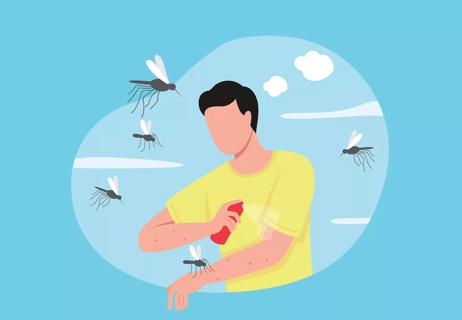Using blunt-tipped tweezers, pull the critter up gently to remove it from your kid’s skin and then bag it to take to a healthcare provider for identification

Pool days, barbecues, ice cream … and ticks? Unfortunately, summer fun goes hand-in-hand with tick season from May to October. And that means parental fears of their kids getting bitten run rampant the closer we get to warm-weather months.
Advertisement
Cleveland Clinic is a non-profit academic medical center. Advertising on our site helps support our mission. We do not endorse non-Cleveland Clinic products or services. Policy
“This can be very emotional for parents,” says pediatric infectious disease specialist Frank Esper, MD. “It’s scary when they find a tick burrowing in, and there’s a lot of concern about the diseases ticks can transmit.”
So, what can you do to prevent tick bites? And what should you do if your child has been bitten? Dr. Esper shares some easy-to-follow guidelines.
Once your child comes in from outside, examine their skin from head to toe, including those hard-to-reach places like in and around their ears, between their thighs and legs, and along their hairline.
When a tick latches on, it hooks its mouthparts under the skin for better grip and holds on until it feeds itself full of blood and falls off. The tick, itself, won’t burrow below the skin, so it should be noticeable, about the size of a small poppy seed or apple seed.

If you find a tick that needs removing, avoid using petroleum jelly or burning it off with a lighter. These tick-removal methods are less effective. Using a lighter increases your or your child’s risk of getting burned, and petroleum jelly allows the tick to stay attached to your skin for even longer.
Instead, grab a pair of blunt-tipped tweezers and follow these steps:
Advertisement
Dr. Esper says the odds that your child has contracted a tick-borne illness are low, even if you live in a tick disease hotspot.
“If you or your child has been bitten by a tick, and it’s been less than 36 hours, the likelihood of it transmitting Lyme disease is less than 3%,” he explains. “For transmission, the tick has to have been feeding on you for two days or more. Even then, we calculate the risk to be 25%. So, that’s still a 75% chance you’re not going to get the infection.”
Other known illnesses that can be transmitted through tick bites include:
So, how can you ensure you reduce the risk of dealing with ticks in the first place? Dr. Esper suggests the following tips to help prevent ticks from setting up shop in your yard and around your house.
Put insect repellents containing DEET, picaridin, oil of lemon eucalyptus (OLE) or permethrin (at least 0.5%) on your skin AND clothing. Ticks are just hanging out, waiting for their dinner. Repellents disguise your body heat and odor, stopping ticks from picking you as their next meal train. Bonus: Permethrin-based repellents can withstand about a month’s worth of machine washings.
Check your pets for ticks, especially if they spend a lot of time outdoors or in woodland areas. Ticks can catch a ride on their hairy backs and make it indoors without being spotted. Plus, dog ticks (or wood ticks) are often twice the size of deer ticks and come with their own set of illnesses that can be transmitted to humans if bitten.
“Most tick exposures happen not during hiking but in people’s yards,” clarifies Dr. Esper. “Well-manicured grass acts as a buffer zone against them. They don’t like open areas.” But take caution around your yard’s edges — or better yet, put in mulch or gravel to prevent ticks from traveling to your grass.
Advertisement
Despite your vigilance, you may not know if your child has been bitten by a tick. While tick disease symptoms can appear at any time, Dr. Esper recommends seeing a doctor if you notice any of these signs:
“Less than 50% of children show generalized signs of illness like chills, headache, fatigue, muscle and joint aches. However, most will show the rash,” explains Dr. Esper.
“The rash often appears within seven days as an expanding, red, circular rash similar to the appearance of a ‘target’ at the site of the tick bite. So, if you remove a tick, monitor that area for the development of the rash. If you see a rash, take a picture and discuss with your pediatrician or healthcare provider about the next steps.”
Advertisement
Learn more about our editorial process.
Advertisement

Keep ‘mozzies’ at bay by avoiding scented body products, beer and certain colored clothes

Vanilla extract won’t keep mosquitoes away for long, if at all — and could even attract other bugs, like wasps or flies

Alpha-gal syndrome has become more common and is a leading cause of anaphylaxis

These red, raised bites often show up in a zigzag pattern on areas of your skin that come into contact with bedding

Twice daily tick checks, the right bug sprays and long pants can help you prevent tick-borne diseases

Bug bites create tiny openings in your skin that can let in dangerous bacteria

Using insect repellent, covering up and keeping your property dry can help keep the buggers at bay

Kissing bugs are insects that can carry a dangerous parasite that causes Chagas disease

Start having sex about 72 hours before ovulation, then at least every other day during your fertile window

Attachment theory suggests that your earliest relationships shape connections throughout your life

It isn’t a recognized mental health disorder, but research shows that problematic social media use can negatively affect your mental health, self-esteem and sleep